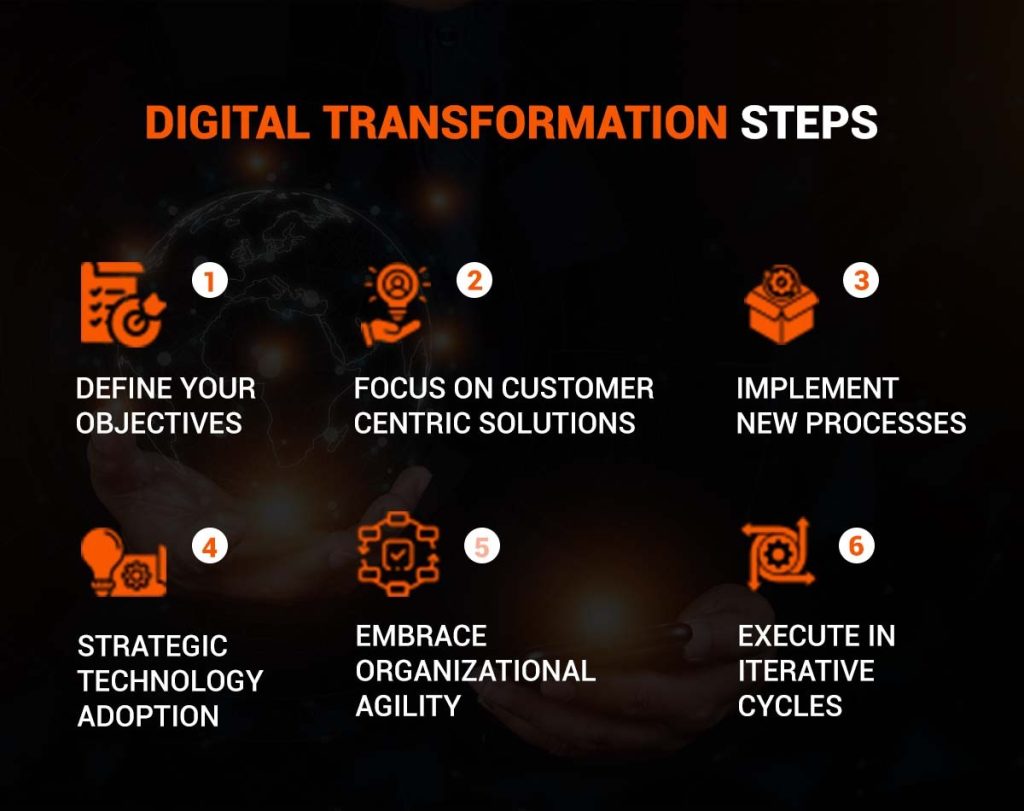Digital transformation is a buzzword you’ve probably heard lately, but what does it mean? Simply put, leveraging digital technology transforms business operations and enhances customer value delivery. It’s not just about upgrading old systems or moving to the cloud, it’s about rethinking how you do everything in your business. From customer interactions to internal processes, digital transformation can make your business more efficient, agile, and competitive. Let’s explore the world of digital transformation and discover why it’s a game-changer for companies everywhere.
What is Digital Transformation
Digital transformation is the critical process that utilizes digital technologies to innovate or enhance business processes, corporate culture, and customer experiences to keep pace with evolving market demands.
This shift towards digitalization goes beyond traditional roles like sales, marketing, and customer service. It requires a comprehensive reorientation of how a business thinks about and interacts with its customers. The digital transformation journey involves assessing processes, overcoming cultural barriers, and adapting to evolving customer expectations and legacy systems.
As business owners adopt intelligent applications for management, the potential for reimagining operations and customer interactions through digital innovation becomes limitless.
From small businesses to large enterprises, the path to business transformation doesn’t necessitate retrofitting existing processes. Instead, you can future-proof your organization by establishing a digitally-driven foundation.
By embracing digital strategies and infrastructure, your business will gain agility, flexibility, and scalability. Explore our insights and guidance for a successful digital transformation.
Why is Digital Transformation Important?
Digital transformation reshapes an organization’s operating model, impacting its systems, processes, workflows, and culture. This evolution integrates data across domains more effectively. Key Benefits Include:

- Operational Efficiency and Productivity: Streamlines operations, eliminates inefficiencies, and optimizes resources, enhancing productivity.
- Enhanced Customer Experience: Delivers personalized experiences, quicker responses, and customized solutions, boosting customer satisfaction.
- Promotes Innovation and Competitiveness: Fosters innovation, enables agile responses to market dynamics, and facilitates introducing innovative products and services.
- Data-Driven Decision Making: Gathering and analyzing data to drive informed decisions, effectively uncovering trends and seizing growth opportunities.
The Benefits of Digital Transformation
Achieving their transformation goals allows digital leaders to realize numerous benefits. These core advantages of digital transformation are interconnected and mutually reinforcing:
- Improved management of resources.
- Enhanced resilience.
- Greater flexibility.
- It has enhanced customer engagement and personalized experiences.
- Increased responsiveness to market demands.
- Modernization of IT infrastructure.
- Encouragement of innovation.
- Accelerated time-to-market for new products and services.
- Increased revenue.
- Sustained relevance.
Digital transformation helps organizations succeed in the digital orbit. Businesses can boost their revenue and profits. Nonprofits and government agencies can improve how they serve stakeholders and the public.
Must Know Facts!
The World Economic Forum predicts digital transformation will contribute $100 trillion to the global economy by 2025.
The global digital transformation market, valued at USD 2.27 trillion in 2023, is expected to increase to USD 12.35 trillion by 2032, with an anticipated annual growth rate of 20.9% throughout the forecast period, starting from USD 2.71 trillion in 2024.
Research and Markets predicts that AR/VR technology will experience the fastest growth until 2025, despite IoT holding the largest share of the overall digital transformation market in 2019.
Digital Transformation Steps
Digital transformation encompasses the strategic integration of digital technology across all facets of a business, fundamentally reshaping its operations and enhancing customer value delivery. Here are the critical steps involved in a successful digital transformation:

Define Your Objectives
A digital transformation strategy begins with clearly defining your objectives and outlining the necessary steps.
Every organization’s digital transformation journey is unique, so it’s crucial to identify specific objectives tailored to your business. Consider these foundational goals:
- How can you enhance the customer experience?
- Can adopting new technologies and processes lead to greater efficiency and cost-effectiveness?
- How can your organization embrace change and adapt as an industry leader?
- Are you leveraging analytics to gather actionable insights swiftly?
By addressing these questions, you’ll pinpoint areas needing attention and prioritize components of your strategy.
Focus on Customer-Centric Solutions
Successful digital transformation hinges on meeting customer needs through digital tools. Therefore, all initiatives should enhance customer value.
For instance, integrating customer management and communication channels streamlines interactions. Centralizing emails and past conversations aids in managing and nurturing customer relationships.
Align internal transformations with customer expectations. Emphasize technologies and processes that facilitate digital evolution.
Implement New Processes
Your current operational methods may not support digital transformation efforts. Introducing new processes is crucial for success.
Some organizations may require comprehensive process overhauls. Engage employees in understanding updates, roles, and supporting systems.
Strategic Technology Adoption
Adopt technology that complements optimized processes. Select solutions aligned with organizational priorities.
Consider technologies that:
- Standardize workflows efficiently.
- Enhance client collaboration within workflows.
- Provide data insights for informed decision-making.
- Facilitate seamless data sharing and workflow automation.
Technology choices should align directly with strategic objectives.
Embrace Organizational Agility
Adopt a flexible organizational structure to support digital readiness. Move away from rigid hierarchies towards agile, project-focused models.
Empowering employees fosters operational autonomy and enhances organizational commitment.
Execute in Iterative Cycles
Implement your plan incrementally to manage complexity effectively. Break down tasks into manageable phases.
The regular team reviews to ensure alignment with objectives scope and prompt adjustments as needed.
Iterative implementation promotes continuous improvement and resource efficiency.
Foster Adaptability
Achieving sustainable digital transformation requires agility and resilience. Plan meticulously and adapt post-implementation.
Monitor performance metrics to gauge adoption and goal attainment. Identify opportunities for enhanced impact and continual improvement.
Reflect on lessons learned to refine strategies and optimize future adjustments.
Digital Transformation Technologies
Almost any digital technology can be part of how a company changes digitally, but these technologies are mainly linked with transformation projects.
Cloud Computing
Cloud computing enables instant access to resources such as storage, databases, and servers via the internet on demand.
Benefits:
- Scalability: Adjust resource capacity flexibly according to demand fluctuations.
- Cost Efficiency: Pay only for what you use, reducing capital expenditure.
- Flexibility: Access data and applications from anywhere, anytime.
- Speed and Agility: Rapid deployment of new services and applications.
Examples: Amazon Web Services (AWS), Microsoft Azure, and Google Cloud Platform.
Artificial Intelligence (AI) and Machine Learning (ML)
AI refers to machines performing tasks that typically require human intelligence. Machine Learning, a branch of AI, empowers systems to learn and enhance themselves through experience without explicit programming.
Benefits:
- Automation: Streamline processes and workflows.
- Predictive Analytics: Forecast trends and behaviors based on data patterns.
- Personalization: Deliver personalized customer experiences.
- Decision Support: Assist in complex decision-making.
Examples: Natural Language Processing (NLP), Computer Vision, Predictive Analytics.
Internet of Things (IoT)
IoT facilitates the connection of devices such as sensors and smartphones to exchange data via the internet, enabling automation and the generation of data-driven insights.
Benefits:
- Operational Efficiency: Monitor and optimize processes in real time.
- Improved Customer Experience: Enable smart homes, connected cars, etc.
- Cost Savings: Predictive maintenance reduces downtime and costs.
- Data-driven Insights: Utilize data for better decision-making.
Examples: Smart Manufacturing, Connected Healthcare Devices, and Smart Cities.
Blockchain
Blockchain is a secure technology that uses decentralized, distributed ledgers to record transactions across multiple computers.
Benefits:
- Transparency and Traceability: Immutable record of transactions.
- Security: Cryptographic algorithms ensure data integrity.
- Cost Efficiency: Reduce intermediaries in transactions.
- Smart Contracts: Self-executing contracts based on predefined rules.
Examples: Cryptocurrencies (e.g., Bitcoin), Supply Chain Tracking, Financial Transactions.
Cybersecurity Solutions
Cybersecurity solutions protect systems, networks, and data from cyber threats.
Benefits:
- Data Protection: Safeguard sensitive information.
- Threat Detection: Identify and respond to threats in real time.
- Compliance: Meet regulatory requirements.
- Business Continuity: Minimize disruptions due to security incidents.
Examples: Firewall Systems, Intrusion Detection Systems (IDS), Encryption Technologies.
5G Technology
5G is the fifth generation of cellular network technology, offering faster speeds, lower latency, and more reliable connectivity.
Benefits:
- High-Speed Connectivity: Support for bandwidth-intensive applications.
- IoT Enablement: Connect more devices simultaneously.
- Enhanced Mobile Experiences: Streaming, gaming, and AR/VR applications.
- Industry Transformation: Enable intelligent cities, autonomous vehicles, etc.
Examples: Mobile Networks, Fixed Wireless Access, Industrial IoT.
How Can Nirvana Lab Help You With Digital Transformation?
Nirvana Lab propels your digital transformation journey with customized solutions to amplify operational efficiency and foster business expansion. From strategic consultancy to implementation of cutting-edge technologies mentioned above, we empower your organization to adapt swiftly to market demands. Our expertise spans across industries, ensuring seamless integration of digital solutions that optimize workflows and elevate customer experiences. Partner with Nirvana Lab to transform challenges into opportunities and embark on a future-ready path of sustainable growth and success.
Frequently Asked Questions
What is digital transformation?
Digital transformation involves fundamentally leveraging digital technologies to alter business operations and enhance customer value delivery. It integrates digital tools and strategies across all aspects of an organization.
Why is digital transformation necessary?
Digital transformation is crucial as it enhances operational efficiency, improves customer experiences, fosters innovation, and enables businesses to stay competitive.
How can digital transformation benefit my business?
Digital transformation can benefit your business by streamlining operations, reducing costs, increasing productivity, enhancing customer satisfaction through personalized experiences, and enabling quicker decision-making based on data-driven insights.
How can Nirvana Lab help with digital transformation?
Nirvana Lab provides tailored solutions to accelerate your digital transformation journey. They offer strategic consultancy and implement cutting-edge technologies like AI and cloud computing to optimize workflows and elevate customer experiences, ensuring your business adapts swiftly to market demands.
What are some key technologies involved in digital transformation?
Key technologies include cloud computing, artificial intelligence (AI) and machine learning (ML), the Internet of Things (IoT), blockchain, cybersecurity solutions, and 5G technology. These technologies enable automation, data analytics, and enhanced connectivity.
